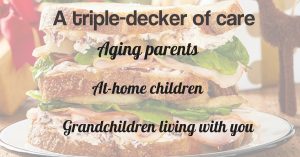What sides come with that sandwich?
as published in the Racine Journal Times | April 17, 2017
We’ve all heard of the sandwich generation – that period of middle-age where we may be responsible for taking care of aging parents at the same time as we’re raising children of our own. Our needs, and often our financial conditions are “sandwiched” between the ongoing and increasing needs of those who came before and those who came after us.
In pondering this life phase, I’ve come to realize that for many, it can actually be more like a triple decker than just your run of the mill sandwich. In the United States, there are more than 2.7 million grandparents who are the primary caregiver for grandchildren. Financial and other forms of support are routinely being dedicated to aging parents, not-fully-independent children, and grandkids who for various reasons may need you to ensure their well-being.
According to the Pew Research Center, there are over 40 million unpaid caregivers of older adults. In the case of caring for aging parents, some of the economic burden can be offset by their own financial resources and a well-formulated and implemented retirement income plan. However, there are other costs including the social, psychological, and emotional prices to be paid. Many sandwichers find it necessary to take a leave from their careers to care for their parents, particularly at late-life. Support in the form of Family Medical Leave Act may protect one’s job in the short run, but it’s limited and no one really knows the long-term impact to your career prospects of taking a lot of time off.
For mid-lifers who are now taking on primary or at least secondary care of grandchildren, the financial toll can be high. While often in a better financial position than when their own children were young, they are also planning for their own later lives and what would have been going into reserves or retirement saving is diverted into the daily care of another generation. Often in the case of grandparents raising grandchildren, the child’s parents also have financial constraints that mom and dad help to shoulder.
The fries on the side of this dish aren’t that tasty either. Rising costs of health care are leading many to reformulate their retirement prospects and financial plans. Costs for housing, food, transportation, consumables, clothing, utilities, and all the other costs are not reduced as we age, but increased — and at a time when the financial burdens should technically be lessening. For many hitting their fifties downsizing, outsourcing, and plain old closures leave them without jobs — just in time for their triple-decker sandwich. The prospects for mid-lifers finding meaningful work and similar pay is more daunting then ever.
For many, eating this sandwich is one they do freely and willingly. They accept the financial and non-financial costs as part of the price for the blessings that come with the meal deal. And there are many.
Speak to your financial advisor and senior life advocates for help in navigating your own triple-decker menu.






